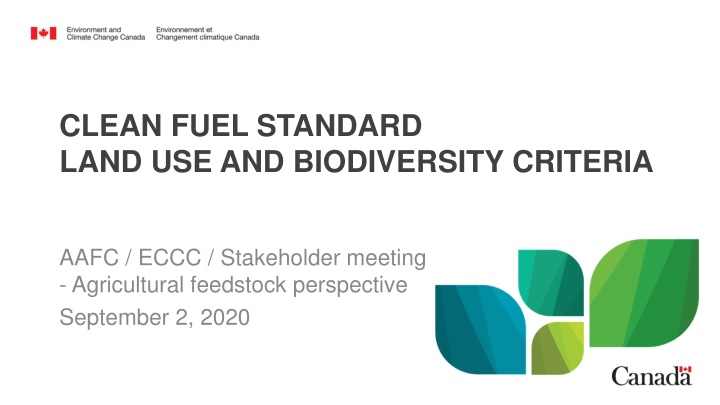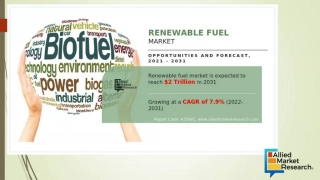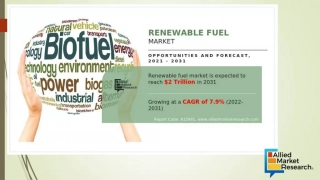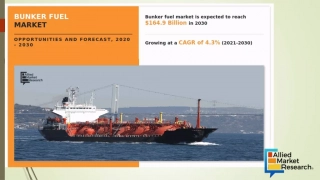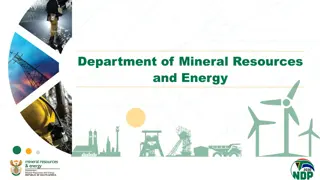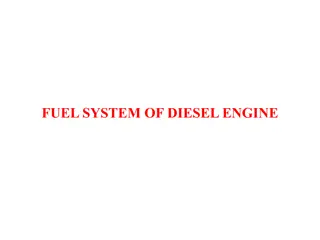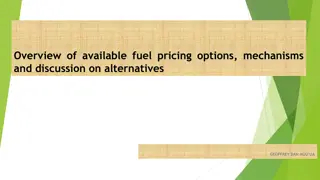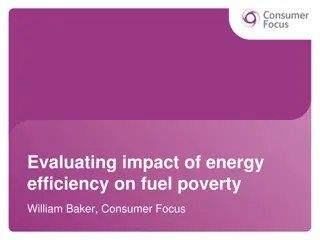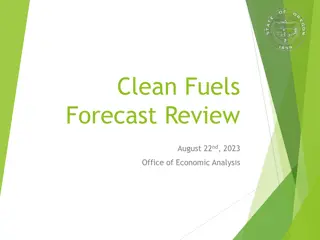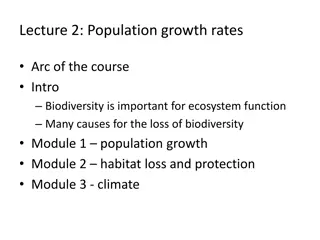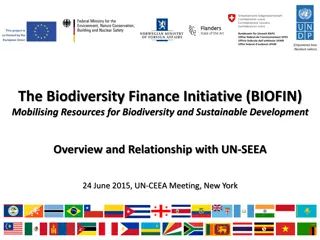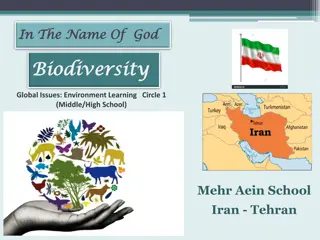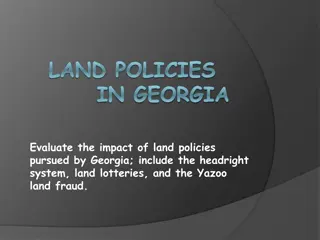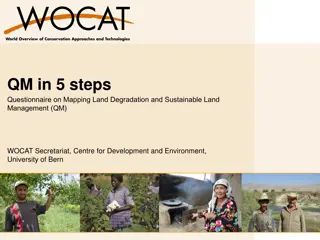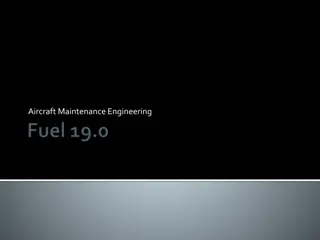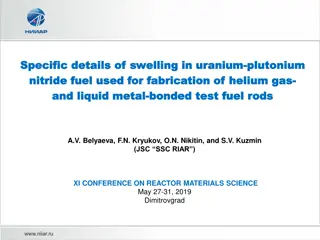CLEAN FUEL STANDARD LAND USE AND BIODIVERSITY CRITERIA
Addressing the intersection of clean fuel standards, biodiversity criteria, and agricultural feedstock perspectives discussed during the AAFC/ECCC stakeholder meeting. The importance of sustainable practices in fuel production and land use highlighted in the discussion held on September 2, 2020.
Download Presentation

Please find below an Image/Link to download the presentation.
The content on the website is provided AS IS for your information and personal use only. It may not be sold, licensed, or shared on other websites without obtaining consent from the author.If you encounter any issues during the download, it is possible that the publisher has removed the file from their server.
You are allowed to download the files provided on this website for personal or commercial use, subject to the condition that they are used lawfully. All files are the property of their respective owners.
The content on the website is provided AS IS for your information and personal use only. It may not be sold, licensed, or shared on other websites without obtaining consent from the author.
E N D
Presentation Transcript
CLEAN FUEL STANDARD LAND USE AND BIODIVERSITY CRITERIA AAFC / ECCC / Stakeholder meeting - Agricultural feedstock perspective September 2, 2020
CONTENTS CFS Overview Land use and biodiversity (LUB) criteria overview LUB criteria All feedstock Agricultural Feedstock Material balance Declarations Demonstrating Compliance 2
POLICY OBJECTIVE Announced in 2016 as part of the Pan Canadian Framework on Clean Growth and Climate Change Clean Fuel Standard aims to address 3 objectives Reduce GHG emissions by lowering the lifecycle carbon intensity of fuels used in Canada Stimulate investment/innovation in low carbon fuels & technologies Minimize compliance costs through flexible compliance options Phased approach Phase 1: liquid fuels (gasoline, diesel) used in mainly in transportation Draft regulations in Canada Gazette, Part I fall 2020, followed by a 75-day consultation period Final regulations in Canada Gazette, Part II in late 2021 Requirements will come into force in 2022 Phase 2: gaseous fuels (natural gas) and solid fuels (petroleum coke) used mainly in industry and buildings Will follow timeline for the liquid fuel regs + 12 months 3
REQUIREMENTS AND COMPLIANCE Fossil fuel producers and importers are required to reduce the lifecycle carbon intensity of their fossil fuels annually, starting in 2022 Requirements separately for each fuel classes (solid, liquid and gaseous) Compliance with the reduction requirement is based on a system of tradeable credits. Primary suppliers must create or acquire sufficient credits annually to match their reduction requirements Credits and reduction requirements are measured in tonnes of carbon dioxide equivalent Participation in the credit system includes primary suppliers and voluntary credit creators Three methods for creating credits: 1. GHG reduction actions along the lifecycle of the fossil fuel that reduce fossil fuel carbon intensity (e.g., reductions during extraction, production, distribution and use) 2. Producing low-carbon fuels for use in Canada 3. Specified end-use fuel switching in transportation 4
LAND USE AND BIODIVERSITY CRITERIA First draft of criteria (previously sustainability criteria ) were published in June 2019 Proposed Regulatory Approach and was closely modeled on EU RED II Since June 2019, have continued to refine LUB criteria Considerations Ensure financial incentives created by CFS do not result in loss of biodiversity from biofuel feedstock cultivation and harvesting Provide clear, objective criteria applicable globally Minimize administrative burden on biofuel feedstock suppliers 5
ELIGIBLE FEEDSTOCK 1 Exempt from LUB criteria and material balancing Not biomass 2 Exempt from LUB criteria and material balancing if sourced from the list provided by CFS Low-concern biomass feedstock Eligible Feedstock 3 Must comply with LUB criteria and material balance requirements All other feedstock 6
NOT BIOMASS FEEDSTOCK Feedstock that are non-bio or not 100% bio-based are exempt from LUB criteria and material balancing Examples Industrial effluents Used construction and demolition materials (not 100% bio-based) CO2 capture from atmosphere or stack emissions to fuel H2 (as feedstock for fuel) 7
LOW-CONCERN BIOMASS FEEDSTOCK Certain feedstocks that are either non plant-based, or are of low land-use-change concern, are exempt from the LUB criteria Examples Animal materials, including manure Used animal litter or bedding Used or inedible organics from a residential area, retail store or restaurant Used fat and used vegetable oils Used construction and demolition materials (bio-based) Industrial effluents (biogenic) Municipal wastewater 8
FEEDSTOCK SUBJECT TO LUB CRITERIA Crop-based and forest feedstocks that are derived from biomass and are not exempted from the LUB criteria as Type 2 Feedstocks must adhere to the LUB criteria (considered to be Type 3 Feedstocks) Examples corn sugarcane sorghum soy canola/rapeseed wood biomass 9
LAND USE AND BIODIVERSITY CRITERIA Separate requirements for forest feedstock, agricultural feedstock and all feedstocks Forest Feedstocks All Agricultural Feedstocks Forest biomass and forest residues (includes all parts of the tree: trunk, bark, branches, needles, leaves, roots) Feedstock Agricultural feedstocks from dedicated energy crops and agricultural residues that are not low- concern biomass feedstock Criteria for both forest and agricultural feedstocks 10
LAND USE AND BIODIVERSITY CRITERIA Riparian zones Protected areas All Feedstocks Prevent introduction of invasive Species Feedstocks subject to LUB criteria High ILUC Crop Based Feedstock Excluded land Forest Based Feedstock Forest management plan 11
CRITERIA FOR ALL FEEDSTOCKS RIPARIAN ZONES Eligible feedstocks must not be cultivated or harvested in a riparian zone A riparian zone is the area within: a) For streams wider than 3m, the farther from the stream of the following measurements: 30m measured on a slope distance from a visible high water mark caused by the presence and action of water or an active flood plain marking the soil or vegetation with a character distinct from the banks of that stream, or 30m from a point where the slope grade above a stream first becomes flatter than 3:1 (H:V) and the average slope grade remains flatter than 3:1 (H:V) for a slope distance of 15 m, measured perpendicular to the stream flow b) 10m of a wetland or lake, larger than 5 ha, measured on a slope distance from A visible high water mark caused by the presence and action of water or an active flood plain marking the soil or vegetation with a character distinct from the banks of that water body 12
RIPARIAN ZONE FOR A STREAM 30 m Visibly distinct vegetation or high water mark Minimum stream width of 3m 30 m Stream 13
RIPARIAN ZONE FOR A LAKE OR WETLAND No distinct vegetation or high water mark Visibly distinct vegetation or high water mark 10 m 10 m Lake or wetland Larger than 5 ha 14
CRITERIA FOR ALL FEEDSTOCKS PROTECTED AREAS Feedstocks must not be harvested from land in an area that has been, at any time, on or after January 1, 2008 designated as a protected area under environmental legislation or by a competent authority, or for the protection of any rare, vulnerable or threatened species or their habitats or of vulnerable ecosystems as recognized by an international agreement, or an intergovernmental or international organization 15
CRITERIA FOR ALL FEEDSTOCKS INVASIVE SPECIES AND APPLICABLE LEGISLATION Feedstocks must be managed in accordance with any applicable laws that prevent the introduction of damaging agents, such as pests, invasive species, and disease, including from its transport cultivated and harvested in accordance with applicable legislation 16
CRITERIA FOR CROP BASED FEEDSTOCK HIGH ILUC-RISK High ILUC-risk crop-based feedstocks are not eligible for CFS credits, based on EU criteria and study of global production area expansions The Commission Delegated Regulation (EU) of 13-3-2019 sets out the criteria for determining high ILUC-risk feedstocks where a significant expansion of the production area into land with high-carbon stock is observed EU Commission study identified the following cumulative conditions for classifying feedstock as high ILUC risk The average annual expansion of the global production area of the feedstock since 2008 has increased by more than 1% and affects more than 100,000 hectares; and More than 10% of this expansion has taken place into land with high carbon stock 17
CRITERIA FOR CROP BASED FEEDSTOCK NON-ELIGIBLE LAND EXPANSION Feedstocks from land defined by one of the categories below, on or after January 1, 2008, are not eligible Forest - an area that contains trees that have or are capable of reaching a height of 5 metres, and provide or are capable of providing a canopy cover of more than 10 percent Wetland - an area that is saturated with water for a period that is long enough to promote the growth of hydrophytic vegetation and biological activity that is adapted to a wet environment Grassland An area dominated by herbaceous or shrub vegetation that has not produced crops for ten years or more, including: Self-seeded or cultivated land, including land used for livestock grazing; and Non-agricultural land that satisfies the ten-year requirement, regardless of human interference (mowing, fertilizing, etc.) 18
CRITERIA FOR CROP BASED FEEDSTOCK AQUATIC ECOSYSTEMS If a biofuel was produced using aquatic plants or algae, the feedstock must not have been cultivated on a pond that is on a regional flood plain, or connected to or draining into natural waters 19
MATERIAL BALANCE Material balance allows flexibility for biofuel production to occur from the physical mixing of eligible and non-eligible feedstock materials It uses traceability and declarations to demonstrate the amount of eligible feedstocks that move through each point in the supply chain to the biofuel producer Each point in the feedstock supply chain, after the point of harvest, demonstrates that the volumes of eligible material that were sold to the next point in the supply chain do not exceed eligible feedstock inputs at the site Where a biofuel is produced from both CFS eligible and non-eligible feedstocks, the number of credits will be based on demonstrated material balances Regulations will set out the material balance process requirements, the records that must be maintained, and the parameters for reporting material balance equations 20
DECLARATIONS Declarations are issued to trace eligible material from any point in the supply chain between feedstock producer and biofuel producer Document accompanies the physical feedstock Declarations are issued by the feedstock harvester, and each point along the supply chain where the feedstock is mixed, divided or processed Copies must be retained by the issuer and the receiver of the feedstock Biofuel producer must have declarations for all feedstock used to create CFS credits Biofuel producers need to work with supply chains to ensure declarations are issued and passed along Farm 1 Farm 2 Collection Point Storage Processing Unit 21
DECLARATIONS CONTENT Name and civic address Geographic boundaries of harvest area Name and location of recipient Date Feedstock type Quantity of feedstock being sold Signed attestation stating the feedstock complies with the LUB criteria Feedstock Harvester Name and civic address Name and location of recipient Date Feedstock type Quantity of feedstock that exits the site Signature Other persons Other persons any entity along supply chain that is not a feedstock harvester (aggregator, biofuel producer) 22
FEEDSTOCK SUPPLY CHAIN DOCUMENTATION AND REPORTING Documentation Requirements Declaration for feedstock shipment Map of feedstock sourcing area If forest feedstock management/monitoring plan Declarations for all feedstock shipments going in Declarations for all feedstock shipments going out Contracts with all farmers and biofuel producers Declarations for all feedstock shipments going in Material balance records Contracts with all feedstock suppliers Sales records of all finished fuels 1. Farmers 2. Aggregator 3. Biofuel Producer 4. Market 23
DEMONSTRATING COMPLIANCE WITH THE LUB CRITERIA Jurisdictional laws and regulations Regulations will set criteria to recognize national or sub-national regulatory frameworks that align with CFS LUB criteria, on a criteria by criteria basis Frameworks would be approved and listed by the Minister Certification A certification scheme is the set of rules and requirements (standards) upon which a certification of conformity is based Regulations will set criteria to recognize certification schemes that align with CFS LUB criteria Scheme would be approved and listed by the Minister Work is in early stages on the above frameworks for the CFS, and consultations are possible with the CFS Technical Working Group, provincial regulators, certification bodies and accreditation organizations 24
DEMONSTRATING COMPLIANCE WITH THE LUB CRITERIA FOR FEEDSTOCK PROVIDERS OR OR RECOGNIZED JURISDICTIONAL FRAMEWORK CERTIFICATION Feedstock provider obtains 3d party certification and provides it in declarations CFS REGULATIONS Feedstock provider indicates recognition in declarations Feedstock provider attests to conformity with LUB requirements in declarations Approved certification scheme must demonstrate conformity with LUB requirements Jurisdiction works with ECCC on assessment of framework 25
